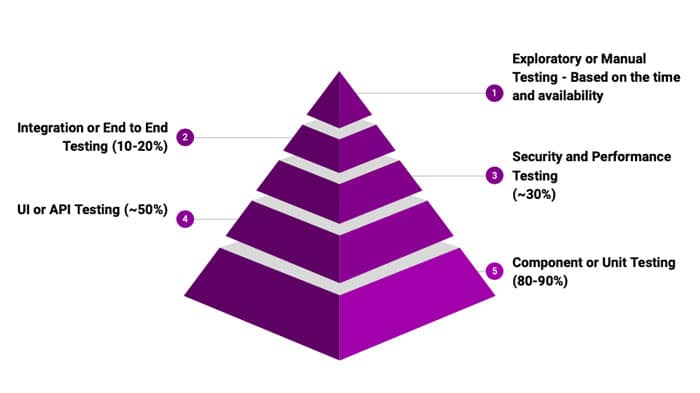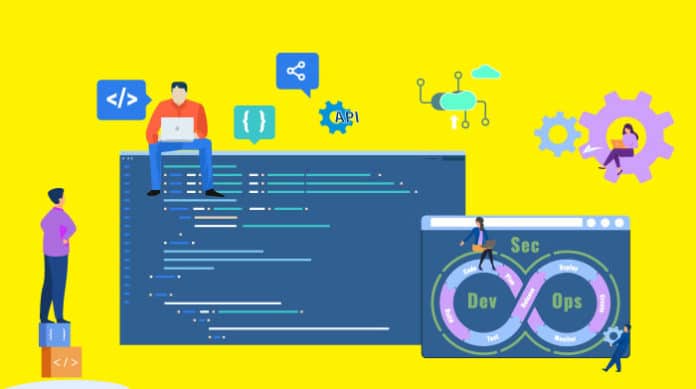In today’s application development world, low-code and no-code software are omnipresent. As developers have to build applications to work across a wide range of devices, including smartphones, understanding the market requirements and the implications of no-code and low-code software is very important today. Low-code and no-code test automation tools help to overcome software development issues across different platforms.
In this article, we will be talking about the technologies and techniques that can help to accelerate test automation. If you are a developer, you will need to shift focus to adapt to some significant changes and if you are running a business, then these new approaches may open up opportunities that will allow you to move faster and be more innovative than ever before.
Low-code (LC)
Low-code is a visual development approach to application development. It enables developers with different experiences to create applications for the backend, Web and mobile, using drag-and-drop components and model driven logic through a graphical user interface. Low-code platforms enable people to write code and build applications with minimum technical knowhow.
No-code (NC)
No-code software, on the other hand, takes the low-code concept to a higher level, allowing literally anyone to create and modify an application as per their needs without any programming knowledge.
Table 1 lists the different components of the LCNC platform along with a brief description of each component.
Now that we know about the different components of LCNC platforms, let us see how they can help in enhancing the quality of the software and in its testing.
Generic problems with continuous testing
Before going ahead, let us list a few of the common problems with continuous testing processes in the software development life cycle.

- Skilling of testers: There are many firms that still rely on manual software testing professionals. They face challenges in meeting the testing needs of agile development cycles as their people are not skilled to support handwritten codes. Learning new technologies involves a lot of training, which adds to the cost and time needed for firms.
- Constant testing: Due to agile development, the progress of the automation tests needs to be revisited — it’s continuous action that requires continuous efforts. This requires significant time, which leads to a delay in the project as developers rely upon testers to begin the next phase of development.
- Repetitive regression cycles: Most of the time, developers add new features to the software that was last tested by the tester. This can cause relapses in past highlights. Testers use regression tests to distinguish this issue. However, manual regression testing is illogical in a fast-paced agile methodology.
- Frequently changing requirements: Many times, senior management in an organisation changes the prerequisites or drops stories during a sprint cycle, despite the fact that this isn’t empowered in an agile/scrum system and no scrum master can facilitate such a request. This means that work half-done pretty well has to be disposed of or altered, which changes the extent of testing out of the blue.
| Components | Description |
| Continuous integration (CI) | CI is a DevOps practice of merging code changes into a version control repository upon task completion. Committing changes triggers the automated build system to use the latest version from the repository, in order to build and run all the automation tests. It finally validates and checks if the code is suitable for release before final deployment to the master branch. |
| Reusability | As LCNC platforms are majorly generalised, reusability makes it easy for developers to use the code from one project to another or create templates. At times, a developer will only need configuration changes to build several systems from the original one. The underlying system does all the work, which allows the developer using LCNC to easily build applications. |
| Omni-channel | Rather than developing and supporting independent code and toolsets for each incompatible target, developers are looking for ways to unify development activities and serve many targets from a single, modular code base. And only make cosmetic changes at a high level. |
| Rules | RPA (robotic process automation) is perhaps the fastest growing LCNC platform. It helps perform tasks that mimic what the user does using rules, with each developer making his or her own decisions. Developers can automate their tasks without writing source code and allow them to run whenever needed. |
| Performance | The LCNC platform has built-in automated testing, proactive quality monitoring, and real-time performance management. But, at times, this can be a bottleneck for developers if they fail to understand the underlying architecture. |
| Cloud based | LCNC platforms provide hosting services and take advantage of a public cloud that automatically manages application reliability and scalability with a simple configuration. This reduces the cost and the effort needed to maintain infrastructure. The solution can also be provided in the cloud (Software as a Service). |
Role of low-code or no-code platforms in agile testing
Agile testing starts at the beginning of a software development phase and is incorporated in the process of test and development. Generally, the testing is done after the coding stage, but in agile methodology, testing is persistent. So testers mediate between project owners and developers. This makes testing a progressive process, and improves the quality of code while making it resilient.
Component testing tools
| Product | Features | Supported platforms | Ratings | Price | Documentation |
| Behave | BDD testing | Python | 2.5K stars on GitHub | Open source | https://behave.readthedocs.io/en/stable/index.html |
| Hypothesis | Property based testing | Python | 5.6K stars on GitHub | Open source | https://hypothesis.readthedocs.io/en/latest/ |
Improved communication and collaboration, and careful delivery and automation of processes results in:
- Delivering high quality code in faster time
- Reduced chances of failure in new releases
- Improved time for fixes and better recovery
API testing tools
| Product | Features | Supported platforms | Ratings | Price | Documentation |
| SoapUI | API test automation framework for soap and REST | Windows, Linux, Mac OS | 1.1K stars on GitHub | Open source | https://www.soapui.org/getting-started/ |
| Rest Assured | Testing REST API | Windows, Linux, Mac OS – Needs to be Java enabled | 4.8K stars on GitHub | Open source | https://rest-assured.io |
The use of efficient tools saves time and improves the quality of the software. This is where automated testing comes in.
UI testing tools
| Product | Features | Supported platforms | Ratings | Price | Documentation |
| Selenium | Web automation tool | Windows, Linux, Mac OS | 18.1K stars on GitHub | Open source | https://selenium-python.readthedocs.io |
| Katalon | Web, API, mobile and desktop app test automation | Windows, Linux, Mac OS | 152 stars on GitHub | Free licence, with paid support services | https://docs.katalon.com/katalon-studio/docs/index.html |
| Appium | Mobile automation testing tool | Windows, Linux, Mac OS | 11.7K stars on GitHub | Open source | https://appium.io/docs/en/about-appium/intro/ |
Automated testing
Automated testing is a software testing technique to test and compare the actual outcome with the expected outcome. This can be achieved by creating test scripts or using any automation testing tool to create tests. Test automation can be used to automate repetitive and other testing tasks which are difficult to perform manually.
The LCNC approach can speed up the process of automating, executing and getting a rapid feedback of the application tests.
Performance testing tools
| Product | Features | Supported platforms | Ratings | Price | Documentation |
| JMeter | Load and performance testing | Windows, Linux, Mac OS |
4.3K stars on GitHub | Open source | https://jmeter.apache.org/usermanual/index.html |
| Locust | Load testing tool | Windows, Linux, Mac OS |
2.3K stars on GitHub | Open source | http://docs.locust.io/en/stable/ |
Low-code or no-code automation tools
Low-code or no-code tools help to overcome software development issues across different platforms. The tables that follow list these tools and give important details about them. Further details can be taken from the documentation links.
Security testing tools
Security testing ensures that Web applications and information systems remain secure.
| Product | Features | Supported platforms | Ratings | Price | Documentation |
| ZAP | Security testing tool | Windows, Linux, Mac OS | 7.4K stars on GitHub | Open source | https://www.zaproxy.org/docs/ |
| w3af | Allows testers to find over 200 types of security issues in Web applications | Linux, Mac OS | 3.2K stars on GitHub | Open source | http://docs.w3af.org/en/latest/ |
All these different types of tools are of great use for testing software in really minimal time, as they help testers to match the pace of CI and CD.
Future of software quality assurance
The process of continuous change will continue to be an important part of software development in the future. However, artificial intelligence will change the software development industry completely, and will, in time, be a part of about every piece of software.
The table above lists ten AI-driven testing tools that make testing more simple, without requiring developers or testers to write a lot of code.
AI-driven testing (AI-DT) tools
| Tools | Features | Documentation |
| Applitools Eyes | Offers visual testing with automation. When applications are developed for different browsers, mobiles and tabs, it becomes difficult to ensure they provide the same features in all. Applitools Eyes is a powerful platform for automated visual testing to help find the differences in the features available in two different kinds of devices. | https://applitools.com/tutorials/ |
| Sauce Labs | Provides a testing platform for Web and mobile applications. It runs Selenium tests from a cloud based server. Even if they have low or no knowledge of programming languages, testers can write fully automated test suites, as Sauce Labs is AI powered. | https://docs.saucelabs.com |
| Testim | In Testim, test cases can be created with or without code, or both. It can record tests and export the code, and is very easy to use even by non-developers. | https://help.testim.io/docs/testim-overview |
| SeaLights | SeaLights’ technology automatically identifies, analyses, and communicates every perceivable quality risk across the entire delivery pipeline by continuously collecting telemetry data from all stages of the SDLC. Its machine learning-like technology examines both your code and the tests that run on it, letting you know exactly what your tests cover and what they don’t. | https://www.sealights.io |
| Test.ai | Test.ai creates test cases for UI based applications. Using AI and ML for identification of elements, it also provides a simple drag-and-drop codeless interface. | https://www.test.ai |
| mabl | mabl is a low-code and no-code cross-browser testing tool. Test cases are added based on AI and ML using the UI. | https://help.mabl.com |
| retest | retest is used to detect functional differences, and also visual differences. | https://docs.retest.de |
| ReportPortal | The ReportPortal AI-powered test automation dashboard acquires, aggregates and analyses test reports across all environments. It provides visibility of the test execution results throughout the pipeline and gives quick feedback. | https://reportportal.io |
| Appvance IQ (AIQ) | Appvance IQ is an AI driven autonomous test creation and continuous testing system. It creates several test scripts and data driven tests speedily using AI. | https://www.appvance.com/docs/UserGuide/ |
| Functionize
|
Functionize is a cloud based automated testing tool for functional, performance, and load testing – it’s a one-stop-shop for all this testing. It is perhaps the most powerful enterprise AI-powered testing tool/platform in the industry. It assists teams in breaking down testing barriers, allowing enterprises to release the product more quickly. | https://www.functionize./ com/ |
Challenges with low-code or no-code
Every solution comes with some hidden problems, and LCNC is no exception. A few of these are:
- Hard to debug and get to lower level of code
- Less control on creating scenarios
- Integration with other tools (not all tools are supported)
- Customisation is difficult
- Vendor lock-in if proprietary tools are being used
- Security risk
Investing in test automation is crucial in order to ensure quality software is delivered in quick time. We should make the best use of low-code and no-code tools for faster automation and release, and also explore the AI-DT tools.




